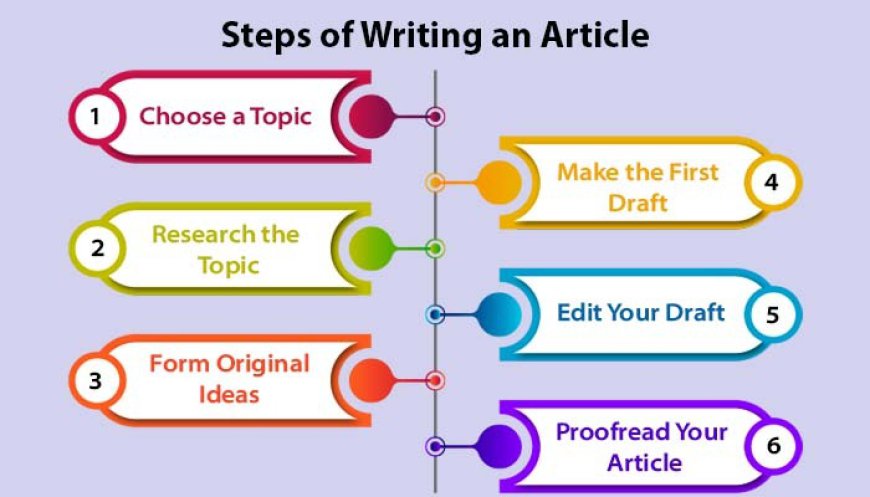Mastering the Art of Writing an Article in English: Tips and Tricks

Are you looking to improve your article writing skills in English? Whether you're a beginner or already have some experience, mastering the art of writing an article in English is essential for success in today's digital age. In this article, we will share valuable tips and tricks to help you elevate your writing game and captivate your readers.
Writing an article in English requires a unique set of skills, from structuring your content to choosing the right words and crafting captivating headlines. Our guide will provide you with practical advice on how to start your article, keep your readers engaged throughout, and deliver a compelling conclusion.
Whether you're an aspiring blogger, a content writer, or simply someone who wants to improve their writing skills, this article is for you. We'll explore effective research techniques, discuss how to outline and structure your articles, and provide valuable insights on how to craft compelling introductions and conclusions.
By the end of this article, you'll have the tools and knowledge to write captivating and conversion-optimized articles in English that rank high on search engines and attract significant reader engagement. Let's dive in and master the art of writing an article in English!
The importance of writing in English
In today's globalized world, English has become the lingua franca of communication. Whether you're aiming to reach an international audience or simply want to enhance your professional prospects, writing in English is crucial. English is the most widely spoken language on the internet, and writing articles in English can significantly expand your reach and impact.
Moreover, writing in English allows you to tap into a vast pool of resources and knowledge that may not be available in your native language. English is the language of academia, business, and technology, and being proficient in English writing can open doors to new opportunities and connections.
To become a skilled English writer, it's important to immerse yourself in the language. Read English articles, books, and blogs regularly to familiarize yourself with different writing styles and structures. Practice writing in English as often as possible to hone your skills and develop your unique voice. The more you write, the better you'll become.
Remember, writing in English is not just about mastering grammar and vocabulary. It's about effectively conveying your ideas and engaging your readers. Let's explore some tips and tricks to help you achieve that.
Understanding your target audience
Before you start writing your article, it's crucial to understand who your target audience is. Knowing your audience will help you tailor your content to their interests, needs, and preferences. Consider demographics such as age, gender, location, and education level. Think about their motivations, challenges, and desires.
One way to understand your audience better is by conducting market research. Look for online forums and communities where your target audience gathers and participate in discussions. Pay attention to the questions they ask, the problems they face, and the language they use. This will give you valuable insights into their mindset and help you create content that resonates with them.
Another effective way to understand your audience is by creating buyer personas. A buyer persona is a fictional representation of your ideal reader. Give your persona a name, age, occupation, and background. Dive deep into their characteristics, interests, and pain points. By visualizing your audience, you can better empathize with their needs and create content that addresses their specific challenges.
Once you have a clear understanding of your target audience, you can tailor your writing style, tone, and messaging accordingly. This will ensure that your articles resonate with your readers and keep them engaged throughout.
Choosing a captivating article topic
The success of your article depends on the topic you choose. A captivating article topic not only grabs the attention of your readers but also sets the tone for the entire piece. Here are some tips to help you choose a compelling article topic:
1. Research popular trends and topics: Stay updated with the latest news, trends, and discussions in your niche. Use tools like Google Trends or social media platforms to identify popular topics that are currently in demand.
2. Consider your audience's interests: Think about what topics would interest your target audience the most. What are their pain points? What solutions are they seeking? Choose a topic that addresses their needs and provides valuable insights or solutions.
3. Be unique and original: While it's important to write about popular topics, it's also crucial to bring a unique perspective or angle to the table. Offer a fresh take on the subject or dive deeper into a specific aspect that hasn't been extensively covered.
4. Use catchy headlines: Once you've chosen your topic, craft a compelling headline that grabs attention and entices readers to click and read your article. A good headline promises value, creates curiosity, or addresses a specific problem.
Remember, your article topic should align with your expertise and interests. Choose a topic that you're passionate about and have sufficient knowledge to provide valuable insights. This will make the writing process more enjoyable and help you deliver high-quality content.
Conducting thorough research
Research is the backbone of any well-written article. Thorough research ensures that your content is accurate, credible, and informative. Here are some tips to conduct effective research:
1. Start with reliable sources: Begin your research by exploring trusted sources such as academic journals, reputable websites, and books. Avoid relying solely on information from forums or personal blogs, as they may not always provide accurate information.
2. Use keywords and search operators: Use specific keywords and search operators to find relevant and up-to-date information. For example, use quotation marks to search for exact phrases or use the minus sign (-) to exclude certain words from your search results.
3. Dive deep into the topic: Don't settle for surface-level information. Dive deep into your topic to uncover unique insights and perspectives. Explore different angles and gather as much information as possible to provide a comprehensive view of the subject.
4. Take notes and organize information: While conducting research, take detailed notes and organize the information you gather. Use tools like Evernote or Google Docs to keep track of your findings, highlight important points, and save relevant links for future reference.
5. Cite your sources: When including statistics, facts, or quotes in your article, make sure to cite your sources. This adds credibility to your content and allows readers to verify the information if needed. Follow the appropriate citation style, such as APA or MLA, depending on your target audience and publication guidelines.
Remember, research is an ongoing process, and it's important to stay updated with the latest information in your field. Regularly revisit your articles to update and enhance them with new findings and insights.
Structuring your article effectively
A well-structured article is easier to read, comprehend, and engage with. It helps readers navigate through your content effortlessly and ensures that your message is effectively conveyed. Here's a step-by-step guide to structuring your articles effectively:
1. Craft an attention-grabbing introduction: Start your article with a compelling introduction that grabs the reader's attention and clearly introduces the topic. Pose a thought-provoking question, share a shocking statistic, or tell a captivating story that relates to your article's subject.
2. Provide a clear and concise thesis statement: After the introduction, clearly state the main argument or purpose of your article. This will guide your readers and set the direction for the rest of your content.
3. Create informative and engaging subheadings: Divide your article into sections with informative and engaging subheadings. This helps readers scan your article easily and find the information they're looking for. Subheadings also make your content visually appealing and break up long chunks of text.
4. Use bullet points and numbered lists: When presenting information that can be categorized or listed, use bullet points or numbered lists. This makes your content more organized, scannable, and easier to digest.
5. Transition smoothly between paragraphs: Ensure smooth transitions between paragraphs to maintain a logical flow throughout your article. Use transitional words and phrases like "furthermore," "in addition," or "on the other hand" to connect ideas and ensure a cohesive reading experience.
6. Wrap up with a compelling conclusion: Conclude your article by summarizing the main points and restating your thesis statement. Provide a call to action or invite readers to share their thoughts or experiences related to the topic. Leave a lasting impression that encourages further engagement and discussion.
Remember, the structure of your article should serve the purpose of your content and align with your target audience's preferences. Experiment with different structures and find the one that works best for your writing style and the subject matter.
Developing strong and coherent paragraphs
Paragraphs are the building blocks of your article. Strong and coherent paragraphs help convey your message effectively and keep readers engaged. Here are some tips to develop impactful paragraphs:
1. Start with a topic sentence: Begin each paragraph with a clear and concise topic sentence that introduces the main idea of that paragraph. This helps readers understand the focus of the paragraph and prepares them for the information to come.
2. Provide supporting evidence and examples: Support your topic sentence with relevant evidence, examples, or anecdotes. This adds credibility to your claims and helps readers visualize and connect with your content.
3. Use descriptive language: Paint a vivid picture with your words. Use sensory language, metaphors, or storytelling techniques to make your content more engaging and memorable.
4. Keep paragraphs concise and focused: Avoid long paragraphs that may overwhelm readers. Instead, break down your content into shorter paragraphs that focus on a specific point or idea. This makes your content more scannable and easier to read.
5. Use transition words and phrases: Transition words and phrases help create a seamless flow between paragraphs. Use words like "however," "in contrast," or "consequently" to indicate relationships between ideas and ensure a smooth reading experience.
Remember, the length of your paragraphs may vary depending on the complexity of the topic and the overall structure of your article. Aim for a balance between concise paragraphs that provide focused information and longer paragraphs that delve deeper into a specific point. Also see: Tech News Updates: OnePlus Unveils Its Maiden Foldable Smartphone Inside the Indian Market
Using persuasive language and writing techniques
To captivate your readers and keep them engaged, it's important to use persuasive language and writing techniques. Here are some tips to enhance your writing style:
1. Use active voice: Active voice makes your writing more engaging and direct. It creates a sense of immediacy and encourages readers to take action. Instead of saying "The mistake was made," say "I made a mistake."
2. Inject emotion into your writing: Emotional language evokes feelings and connects with readers on a deeper level. Use words and phrases that evoke emotions such as joy, fear, or curiosity. However, be mindful of the tone and context of your article, and ensure that the emotions you evoke are appropriate for your audience.
3. Incorporate storytelling: Humans are wired to respond to stories. Incorporate storytelling techniques into your articles to make them more relatable and memorable. Share personal anecdotes, case studies, or success stories that illustrate your points and resonate with your readers.
4. Use rhetorical devices: Rhetorical devices add flair and impact to your writing. Employ techniques such as alliteration, similes, or rhetorical questions to make your content more engaging and memorable.
5. Inject humor (when appropriate): Humor can be a powerful tool to engage readers and make your content more enjoyable. However, use humor sparingly and ensure that it aligns with the tone and purpose of your article. Be mindful of cultural sensitivities and avoid offensive or inappropriate jokes.
Remember, persuasive language and writing techniques should enhance your content and make it more compelling. However, avoid overusing them to the point where they distract from the main message or sound forced. Use them strategically and with intention.
Editing and proofreading your article for perfection
Writing a great article is just the first step. Editing and proofreading are crucial to ensure that your content is polished and error-free. Here are some tips to help you edit and proofread your article effectively:
1. Take a break before editing: After writing your article, take a break before diving into the editing process. This allows you to approach your work with a fresh perspective and catch errors or inconsistencies more easily.
2. Read your article aloud: Reading your article aloud helps you identify awkward sentence structures, grammatical errors, and inconsistencies in tone or flow. Pay attention to the rhythm and cadence of your sentences and make necessary adjustments.
3. Check for grammar and punctuation: Proofread your article for grammar and punctuation errors. Use grammar-checking tools like Grammarly or Pro Writing Aid to catch any mistakes that may have slipped through.
4. Ensure clarity and coherence: Read through your article to ensure that your ideas are clearly expressed and logically connected. Remove any unnecessary or redundant information that may confuse readers.
5. Check for consistency: Ensure consistency in tone, style, and formatting throughout your article. Use the appropriate style guide for your target audience and publication guidelines.
6. Ask for feedback: Share your article with a trusted friend, colleague, or mentor and ask for their feedback. They may spot errors or provide valuable suggestions for improvement.
Remember, editing and proofreading are essential steps that should not be rushed. Take your time to ensure that your article is error-free, coherent, and compelling. The extra effort will make a significant difference in the quality of your final piece. Also see: Education News India Follows Us for More Updates Like Us on our Facebook Page: Click Here Like Us on Instagram: Click Here




























